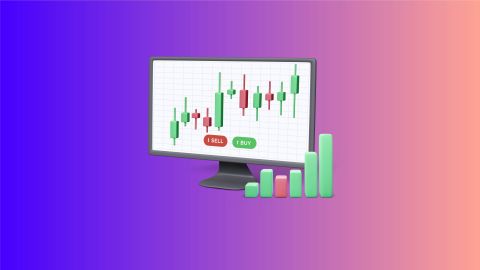How algorithmic trading works?
Algorithmic trading involves creating a set of instructions or code that enables a computer to automatically buy or sell securities like stocks, futures, or options. These trades are executed based on predefined parameters such as price, volume, timing, or complex mathematical models.
1. Trade criteria
The trading strategy employed involves the following criteria:
- Buy signal: Initiate a long position (purchase 50 shares) when the 50-day moving average of the stock price surpasses the 200-day moving average.
- Sell signal: Liquidate the existing position (sell all shares) when the 50-day moving average falls below the 200-day moving average.
2. System implementation
This trading strategy is executed through an automated system. The system continuously monitors the stock price and calculates the 50-day and 200-day moving averages in real-time. Upon detection of the specified buy or sell signal, the system automatically places the corresponding order.
3. Benefits
This automated approach eliminates the need for manual price monitoring, chart analysis, and order placement. By identifying and capitalizing on trading opportunities algorithmically, the system enhances efficiency and reduces the potential for human error.
Strategies for algo trading
If you are a seasoned trader, you may already be familiar with various manual trading strategies. Many of these techniques can also be used in algo trading. Let’s take a closer look at how to do algo trading using some popular trading strategies.
Trend following
This strategy focuses on identifying and capitalising on existing market trends using historical data to predict future price movement. You’d assume that the current trend will persist and position yourself in the same direction as the trend to benefit from its continuation.
Arbitrage
Arbitrage exploits price differences for the same asset across markets. It involves buying and selling simultaneously to benefit from discrepancies. This often demands sophisticated algorithms for rapid execution to secure profits before the price gap closes.
Mean reversion
Mean reversion strategies assume asset prices tend to return to their long-term average. You would look for substantial deviations from historical norms, trading on the expectation that the price will revert to its mean over time.
Index fund rebalancing
This involves anticipating changes index funds make to align with their benchmarks. Traders aim to act ahead of these adjustments, forecasting how large-scale fund activity might impact stock prices during the rebalancing period.
Market timing
Market timing strategies aim to pinpoint ideal moments to enter or exit trades by analysing indicators and market signals. The goal is to maximise returns by accurately predicting short-term price movements, requiring sharp analysis and swift execution.
MTF explained with benefits and eligibility criteria
Benefits of algo trading
Now that you know what algo trading is and how to do algo trading using common trading strategies, let’s take a closer look at the benefits of algo trading. These benefits include the following:
Traders receive optimal pricing on trades.
Trade orders are placed instantly and accurately.
Orders are executed quickly to minimise adverse price movement.
Emotional and psychological trading errors are significantly reduced.
Transaction costs are lower.
Multiple market conditions can be evaluated simultaneously.
Manual entry errors are greatly minimised.
Strategies can be tested using historical and real-time data.
Ideal for time-sensitive trading operations.
Disadvantages of algorithmic trading
Drawbacks of algorithmic trading are as follows:
- Latency: Algorithmic trading necessitates rapid execution speeds and minimal latency to prevent missed opportunities or financial losses due to delayed trade execution.
- Black swan events: Algorithmic trading relies on historical data and mathematical models to predict market trends. However, unforeseen market disruptions, commonly referred to as "black swan events," can lead to significant losses for algorithmic traders.
- Technological dependence: Algorithmic trading heavily relies on technology, including computer programs and high-speed internet connections. Technical issues or failures can disrupt trading processes and result in financial losses.
- Market impact: Large algorithmic trades can significantly impact market prices, potentially leading to losses for traders who cannot adjust their positions accordingly. Moreover, algorithmic trading has been implicated in increased market volatility, including instances of "flash crashes."
- Regulatory compliance: Algorithmic trading is subject to various regulatory requirements and oversight, which can be complex and time-consuming to adhere to.
- High capital costs: The development and implementation of algorithmic trading systems can be expensive. Traders may also incur ongoing fees for software and data feeds.
- Limited customisation: Algorithmic trading systems operate based on predefined rules and instructions, potentially limiting traders' ability to tailor their trades to specific needs or preferences.
- Lack of human judgment: Algorithmic trading relies on mathematical models and historical data, neglecting subjective and qualitative factors that can influence market movements. This absence of human judgment can be a disadvantage for traders who prefer a more intuitive or instinctive trading approach.
Conclusion
You need the right platforms and tools to fully leverage the many algo trading benefits. Today, many leading stockbrokers offer algo trading apps to help retail traders automate their trading strategies. However, before you use these tools, you must become well-acquainted with how to do algo trading in different market conditions.
Related articles
How To Do Bank Nifty Intraday Options Trading
What Is The Difference Between Demat And Trading Account
How To Use Pivot Point In Intraday Trading
Difference Between Online And Offline Trading
What Is Commodity Trading





